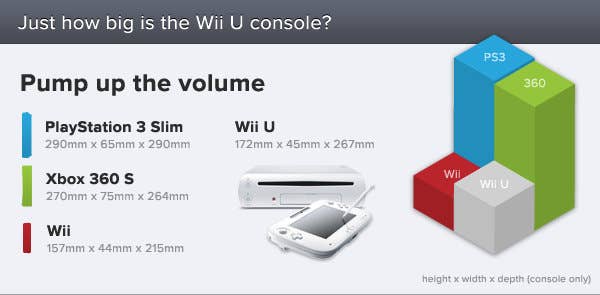In Theory: Can Wii U Offer Next-Gen Power?
Digital Foundry assesses what we know about the Wii U and what it tells us about the console's level of performance
It's been a week of measurements, comparisons and percentages. The next-generation Xbox will be six times more powerful than the 360, and 20 per cent more powerful than the Wii U. As for Nintendo's next-gen console, apparently that's packing twice the power of Microsoft's current offering. Meanwhile, as Digital Foundry recently revealed, Raspberry Pi's graphics core features 2x the performance of the SGX543 MP2 in the Apple iPhone 4S. Of all of the above, we strongly suspect that only one will actually be backed up by meaningful benchmarks (hint: it's the last one).
A Wii U that significantly outperforms current gen consoles would be wonderful, but the facts established to date suggest that 'power' isn't Nintendo's primary concern.
As for the Wii U and Nextbox figures, we're almost certainly as much in the dark as we ever were. One thing we really need to nail down straight away though is the concept of "power" and how it is measured - no actual metrics are attached to the rumours, essentially making the statements rather ambiguous but we'll assume they relate to processing and rendering performance. That being the case, the notion of Microsoft basing its next-gen machine around a £50 graphics core with low-end PC gaming performance only makes sense if it's planning to make the console exceptionally cheap from launch, with a Wii-style limited lifespan. Somehow, the idea of sustaining a console generation until 2020 and beyond with a Radeon HD 6670 seems somewhat improbable.
But what of the idea that Wii U is twice as powerful as the Xbox 360? It's the sort of story that we would really want to believe, but a look at everything we do know about Wii U suggests that it's not very likely.
So what are the facts at hand? Well, we know that IBM is providing the CPU, and we know that it's being fabricated at 45nm - the same process as that used for the combined CPU/GPU in the Xbox 360 Slim, and the core components of the PlayStation 3. We also know that AMD is providing the Wii U GPU, based on existing Radeon technology and featuring "high-definition graphics support; rich multimedia acceleration and playback; and multiple display support".
Crucially, we also know how big the Wii U is, and it's a hell of a lot smaller than either Slim rendition of the Xbox 360 and PlayStation 3. Why is this important? It's simple: typically, the more power you're packing, the bigger the case of the machine and the meatier its cooling assembly. Let's look at the respective volumes of the HD consoles in comparison with the Wii U, with the original Wii thrown in for good measure.

The PS3 is the biggest of the lot according to the graph - but it has a curved casing so actual volume will be lower, and of course, it's also packing an internal power supply. The really interesting comparison is the Xbox 360s up against the Wii U, both of which have external power bricks: we're seeing that Xbox 360s casing has around 2.6 times the volume of the new Nintendo console. The only real differences are that the 360 additionally houses a 2.5-inch hard drive and Wii U is almost certainly using a smaller, slimmer slot-loading drive compared to the more standard-sized unit in the Microsoft console.
Now, the latest Xbox revision is a good, reliable design - but it can still get very warm to the touch. So the question is simple: how can Wii U be twice as powerful as the Xbox 360 when it's got to cram in more advanced silicon with millions more transistors into an area that's tiny by comparison? Won't it overheat horribly? Where's the room for the substantial cooling assembly it would require?
In theory, we could look at laptops here as an example of getting powerful chips working in smaller areas. The problem here is that high-power mobile GPUs are highly 'binned' - they're the pick of the production crop of processors destined for a broad range of different graphics cards. Mobile parts are typically the very best chips, the cream of the crop, capable of great performance at low voltages. Nintendo would not have this luxury on a mass-production item with a single design, where high efficiency is the key to keeping costs down as much as possible.
Realistically, short of a major architectural shift to components based on smartphone tech - and lots of it - the idea of Wii U possessing next-gen rendering capabilities doesn't make a lot of sense. We know that there's no transition to mobile tech because the IBM CPU is an off-shoot of an existing line and the firm doesn't make mobile CPUs. Similarly, while AMD has produced smartphone GPUs, none of them get close to the performance of the Xbox 360's Xenos GPU. That being the case, the chances are that it's a customised variant of an existing PC Radeon part: Japanese sources have previously hinted at a connection to the Radeon HD 4000 series - and a lower-end chip from that range would be a good fit.








